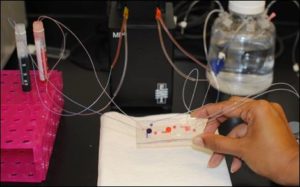
The Wake Forest Institute for Regenerative Medicine (WFIRM) has recently received a $24 million federal grant from the U.S. Department of Health and Human Services (HHS) to support their lung-on-a-chip regenerative medicine technology. This grant was announced on Tuesday and will aim to use the device as “a model to develop chemical injury treatments.” An initial contracting commitment of $13.5 million has been approved for the first 2 years of the five-year program.
This funding stems from the Biomedical Advanced Research and Development Authority (BARDA), which is a part of the HHS Office of the Assistant Secretary for Preparedness Response and will go towards validating how the lung-on-a-chip technology functions in modeling the effects of chlorine gas on the human lungs and to create therapies.
The study of respiratory health, diseases, and treatments is typically done through animal studies or culture models using animal or human cells. With this funding, the WFIRM team will be able to advance further develop their innovative chip that models the lung organ tissue. The chip can be used to model healthy and diseased tissue, with immune system activity and response to drugs or toxins included as well.
“Our lung-on-a-chip technology has grown out of our body-on-a-chip research, a system of miniature human organs created in the laboratory that can be used to further our understanding of the effects of inhaled chlorine gas and other toxins, as well as potential treatments,” said WFIRM Director, Anthony Atala, M.D.
The WFIRM team will be working with genetic researchers from Precision Medicine to not only characterize how chlorine gas and other harmful substances affect the lungs but to evaluate the chip’s usefulness in developing therapies for related respiratory pathologies as well.
Why Chlorine?
Chlorine gas was used as a chemical weapon during World War I and is currently being used in the civil war in Syria, as per BARDA. As for the threat of chlorine damage to the lungs in the US, the quantity of the chemical that is manufactured, available, and used makes it a threat to respiratory health. Chlorine is the most frequently used industrial gas in the US and causes incidental fatalities as well, with a 2005 train accident and subsequent leak of chlorine gas causing nine deaths and at least 250 injuries.
How the Lung-on-a-Chip Works
This chip platform stems from WFIRM’s body-on-a-chip project, which develops miniature human organ systems that model how the body responds to various compounds. To develop the chip, human cells are used to manufacture 3D organ-like structures referred to as tissue equivalents. These small structures mimic the function of organs such as the liver, heart, and in this case, the lungs.
Once generated, these structures are placed on a 2-inch chip and connected to a system of fluid channels and sensors to monitor individual organs and the overall organ system in the body-on-a-chip. A blood substitute keeps  these cells alive and is used to circulate compounds and therapies of interest to these artificial organs.
these cells alive and is used to circulate compounds and therapies of interest to these artificial organs.
Channels are used to guide these agents from tissue to tissue, with sensors measuring temperature, pH, oxygen levels, and other metrics in real-time. This chip platform can be used in personalized medicine as well, using the patient’s cancer cells to screen different chemotherapy treatments to identify what works best.
“We look forward to pursuing the long-term goal of this research with BARDA, which is to reduce the overall burden of in vivo testing in the development and management of products for human clinical use and to speed up the development of treatments,” Atala concluded.
The Wake Forest Institute for Regenerative Medicine
The Wake Forest Institute for Regenerative Medicine is recognized as an international leader in translating scientific discovery into clinical therapies, with many world firsts, including the development and implantation of the first engineered organ in a patient. More than 450 scientists collaborate on regenerative medicine research at the institute, the largest in the world, working on more than 40 different tissues and organs. WFIRM has led the world in clinical scale tissue engineering and a number of the basic principles of tissue engineering were first developed at the institute. WFIRM researchers have successfully engineered replacement tissues and organs in all four categories – flat structures, tubular tissues, hollow organs, and solid organs – and nine different cell/tissue therapies, such as skin, urethras, cartilage, bladders, muscle, and vaginal organs have been successfully implanted into human patients.
More on HHS, ASPR, and BARDA
HHS works to enhance and protect the health and well-being of all Americans, providing for effective health and human services and fostering advances in medicine, public health, and social services. The mission of the Office of the Assistant Secretary for Preparedness and Response (ASPR) is to save lives and protect Americans from 21st-century health security threats. Within ASPR, BARDA invests in the advanced research and development, acquisition, and manufacturing of medical countermeasures – vaccines, drugs, therapeutics, devices, diagnostic tools, and non-pharmaceutical products needed to combat health security threats. Click here for more about ASPR and BARDA and here to learn more about partnering with BARDA.
With a $24-million award from @BARDA, @WFIRMnews will use its lung-on-a-chip technology to potentially advance national security. Read more about this amazing innovation, which stems from the @WFIRMnews body-on-a-chip program. https://t.co/c9WGRCy4wu @HHSGov #research #awards pic.twitter.com/f2QPfbCxKY
— Wake Forest School of Medicine (@wakeforestmed) October 8, 2019







 © 2025 Mashup Media, LLC, a Formedics Property. All Rights Reserved.
© 2025 Mashup Media, LLC, a Formedics Property. All Rights Reserved.